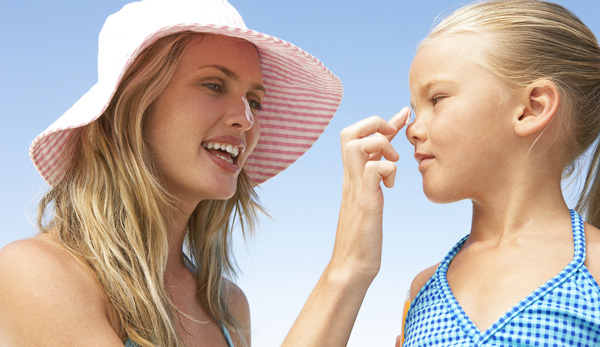Sun & Skin

Ultraviolet radiation (UV) from the sun is composed of three wavelengths – UVA, UVB and UVC. UVA and UVB play different roles when it comes to tanning, burning, and photo aging.
About UVA radiation
UVA is a long wavelength and accounts for up to 95 per cent of the sun's UV radiation that reaches the earth. UVA rays are long and penetrate deep into the skin. UVA rays even penetrate glass and clouds and thus, we are constantly exposed to large doses of it. They damage the skin causing wrinkling, sagging and premature aging; also playing a role in skin cancer.
About UVB radiation
UVB is in the middle range of the UV spectrum. It is responsible for burning, tanning, accelerating skin aging and also plays a key role in the development of skin cancer. The most significant amount of UVB hits between 10 am and 4 pm. UVB rays do not penetrate glass. Overexposure to it causes tough, leathery pigmented skin and uneven texture.
About UVC radiation
- UVC is completely absorbed by the ozone layer and does not affect the skin.
- Direct sun exposure between 10 am to 4 pm should be avoided.
Sunscreen and its uses
Sunscreen is the most valuable cosmetic product that one can use regularly to prevent early sun damage of the skin.
The sun produces both UVA and UVB radiations which can cause sun tan, sunburn on exposed areas. A single exposure can lead to painful, red sunburned skin. Long term sun exposure can cause photo aging, wrinkles, freckles, age spots and a change in the texture of the skin. A sunscreen is essential for all age groups. A good sunscreen should be a combination of chemical blockers such as salicylates, cinnamates and physical blockers such as titanium dioxide and zinc oxide.
A good sunscreen
- A good sunscreen should be cosmetically acceptable for the patient's compliance.
- It should be broad spectrum and protect against both UVA and UVB.
- It should have a combination of chemical and physical blockers.
- It should have components that are not known irritants or allergens.
- It should be waterproof.
- A good sunscreen can be non-comedogenic and also cost-effective.
Sunscreen and skin types
- For oily skin, use lightweight waterproof, sweat-proof, non-comedogenic, oil-free and paraben-free sunscreens.
- For dry skin, use melting texture, colourless sunscreens that leave neither oily film nor white traces; they should be non-comedogenic and photostable.
When to use sunscreen
A sunscreen should be used through the year and not only in summer months. It is a myth, that sun protection is not needed on a cloudy day; such a day will only have 20% less UV radiation. High in the snowy mountains or on sun-kissed beaches, severe sunburn occurs, and in such cases one needs a sunscreen with higher SPF. Even when you are indoors for long periods or commuting by cars, sunscreen is essential as UVA rays penetrate through window glass.
Other methods of photo protection
- Wear loose and dry cotton clothing.
- Avoid peak sun between 10 am to 4 pm.
- Use sun glasses and a broad brimmed hat.
- Use foundations or face powders that have SPF, thus providing marginal protection.
- Avoid perfumes as the psoralens in them can react with the sun leading to pigmentation; instead spray it onto clothes.
SPF and its significance
SPF denotes the length of time you can safely stay in the sun without getting redness or sunburn. SPF of 30 or higher is recommended. Sunscreen should be applied at least 15 to 20 minutes before exposure and reapplied every 2-3 hours. SPF does not indicate tan prevention.
Labels on a sunscreen
Broad spectrum – Protects against both UVA and UVB
Water-resistant – Retains the SPF even after 30 to 40 minutes of water immersion
MYTHS ABOUT SUN AND SKIN
MYTH 1 – I don't need a sunscreen in the morning
UVA and UVB rays hit their peak between 10 am and 4 pm. UVA rays are present whenever it's light outside, even in the morning or late afternoon, during the winter or on cloudy days. So a sunscreen is always required.
MYTH 2 – If I wear a sunscreen of SPF 70, I need not worry
Protection offered by higher SPFs is minimal – – SPF 15 screens 93% of the sun's UVB rays, SPF 30 protects 97% and SPF 50 protects against 98%. Seeing a broad spectrum on the bottle of a sunscreen is more important as it provides protection against both UVA and UVB rays.
MYTH 3 – Water-resistant means "waterproof"
Sunscreen isn't waterproof, it is water-resistant, which means a dip in the water won't wash it off but will enable it to stay on longer than regular sunscreens. Also, it will not stay on the whole day after you've taken a plunge in the water and towelled off. Thus, it needs to be reapplied so as to having continued effect.
MYTH 4 – I need direct sunlight for Vitamin D
Long-term sun exposure is neither a safe nor an efficient way to boost Vitamin D intake. Only the early morning sun, between 7 and 9.30 am for just 15 minutes is good and safe for Vitamin D production. Efficient and healthy levels of Vitamin D can be obtained through a diet rich in it as well.







